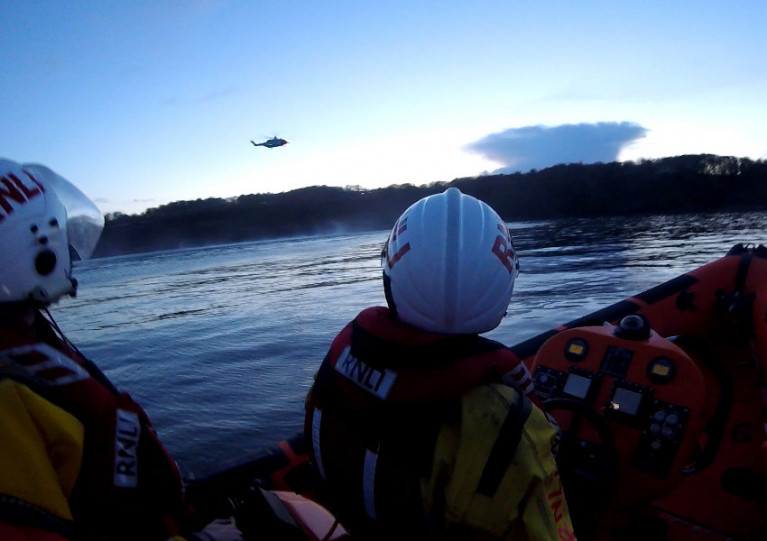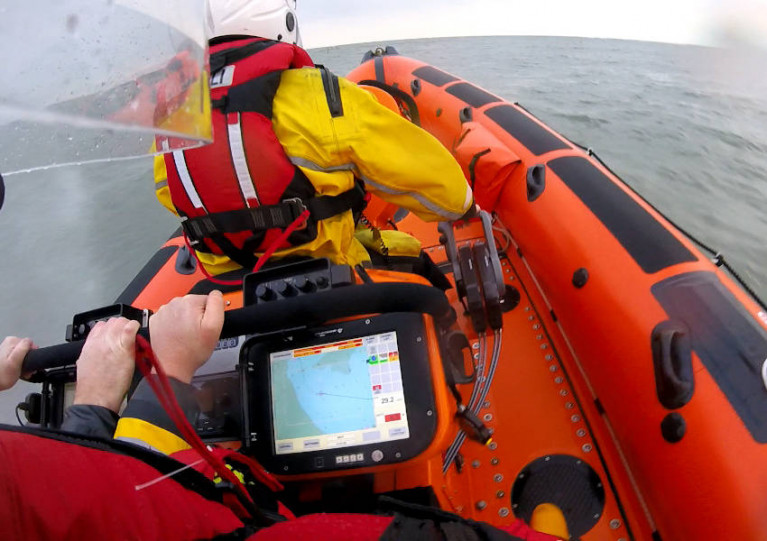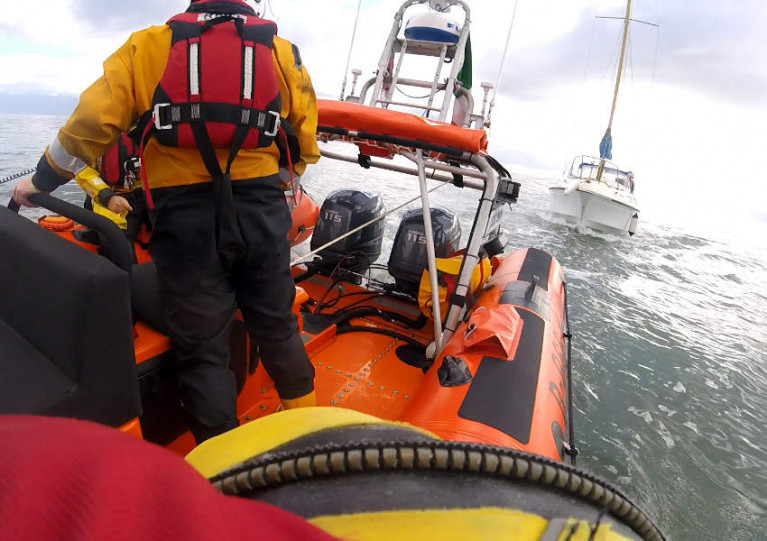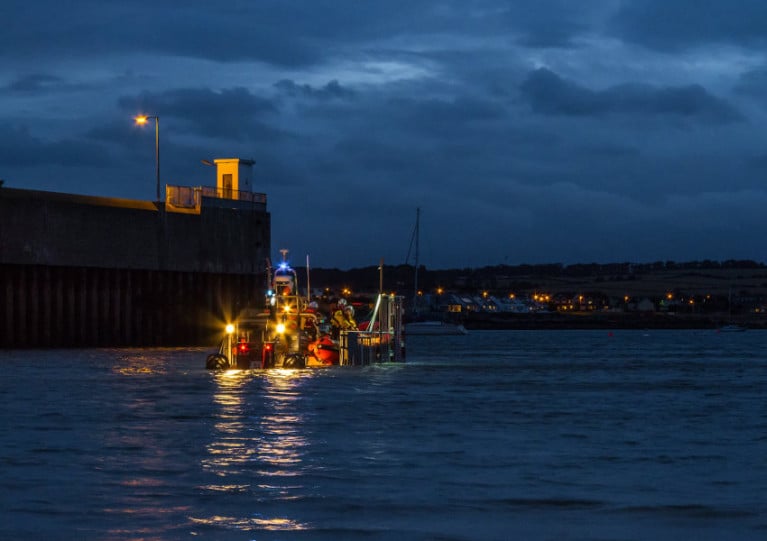Displaying items by tag: Skerries
Busy Weekend of Callouts for Skerries Lifeboat Volunteers
Skerries RNLI’s volunteer crew had a busy weekend responding to calls to stranded walkers on Friday (22 January) and a missing swimmer today (Sunday 24 January).
Shortly before 4.30pm on Friday afternoon, Dublin Coast Guard tasked Skerries RNLI following a call from An Garda Síochána reporting that a number of people had been cut off by the rising tide on Barnageeragh beach.
The lifeboat was launched and proceeded to the area indicated, where the crew quickly spotted one adult and three children at the base of the cliff above the waterline.
While the casualties were uninjured, conditions underfoot in the area were very poor due to a large number of submerged rocks covered in seaweed and algae.
Following a consultation with members of the Skerries Coast Guard unit who were at the top of the cliff, it was decided that due to the falling temperatures and rapidly fading light, the safest option would be to request the assistance of the Dublin-based Irish Coast Guard helicopter Rescue 116.
A crew member stayed with the casualties to reassure them and keep them calm until the helicopter arrived and winched them aboard.
Then today, Sunday 24 January, the volunteer crew were paged shortly after 12.30pm following a call from a concerned family member when a swimmer in Skerries had not returned at the expected time.
The lifeboat launched immediately and made its way around the headland to the swimming platform known locally as The Springers.
Upon arrival it was quickly established that the swimmer had since made it safely ashore. They were well equipped for cold water swimming and required no assistance. The lifeboat was stood down and returned to the station.
Speaking about the callouts, which came a week after the town’s first of the year, Skerries RNLI’s Gerry Canning said: “Friday afternoon was a fantastic example of how well all the emergency services work together, with full-time emergency service personnel and volunteers working alongside each other seamlessly to get the best possible outcome.
“Thankfully the call for the swimmer on Sunday was a false alarm with good intent. We encourage anyone who thinks someone may be in difficulty in or near the sea to dial 999 or 112 and ask for the coastguard. The earlier they make that call the better.”
Skerries RNLI carried out their first rescue of the new year in the early hours of yesterday morning (Saturday 16 January), towing a razor fishing boat with two men on board to safety.
Shortly before midnight on Friday, Dublin Coast Guard requested Skerries RNLI to launch their Atlantic 85 inshore lifeboat following a distress call from a razor fishing vessel that had suffered mechanical failure off the north Co Dublin coastal town.
The lifeboat was launched and the volunteer crew navigated to the GPS position provided by the vessel. A tow was established and the vessel was towed back to the safety of the harbour in Skerries.
Skerries RNLI’s volunteer crew were tasked on Saturday afternoon (28 November) after a call to emergency services reported concerns over a group of sea swimmers off Donabate.
The Atlantic 85 inshore lifeboat Louis Simson was launched shortly before 3pm to investigate the group’s reported position, drifting north from Donabte Beach.
Also tasked were Skerries Coast Guard and the Irish Coast Guard’s Dublin-based helicopter Rescue 116, whose crew made contact with the swimmers and determined they were not in any difficulty. All rescue crews were then stood down.
Speaking later, Skerries RNLI press officer Gerry Canning said: “There has been a marked increase in the number of people taking up sea swimming this year, and as a result there have been increased demands on all the search and rescue organisations.
“Thankfully in this case it was a false alarm, but it’s a good opportunity to remind people to be aware of the additional challenges that apply to sea swimming at this time of the year.”
Skerries Lifeboat Rescues Father & Son Cut Off by Tide on Shenick Island
A father and son were rescued by Skerries RNLI after they were stranded on Shenick Island by the rising tide yesterday afternoon (Tuesday 27 October).
Pagers sounded for the lifeboat volunteers at 3pm and within minutes the Atlantic 85 inshore lifeboat Louis Simson was headed to the scene for a search of the north Co Dublin coastline.
They soon spotted two people — a father and his teenage son — on the beach near the submerged bar between the island and the mainland.
The lifeboat was manoeuvred into the shallow waters, close enough to send a crew member ashore to further assess the situation.
Following the advice of the crew, the father and son were brought aboard the lifeboat and taken back to the south beach in Skerries where they had left their belongings.
Speaking about the callout, Skerries RNLI press officer Gerry Canning said: “We appreciate that people are keen to get out and explore the coastline near them at this time.
“However, we would remind everyone to always keep a means of contacting the shore with them and to check the local tides before setting out.”
Skerries Lifeboat Tows Drifting Yacht To Safety
Skerries RNLI recently launched to the rescue of a yacht with one person aboard that was adrift in the Skerries Islands.
The incident occurred on Thursday morning 15 October, when the yacht made a VHF distress call that was relayed to the local lifeboat by the Irish Coast Guard in Dublin.
Lifeboat volunteers launched the Atlantic 85 inshore vessel Louis Simson shortly before 10am and headed to the reported location, some two miles east of the islands.
As they rounded the headland at Red Island, however, they spotted an eight-metre yacht between Colt Island and Shenick Island that did not seem to be making way.
The crew checked on this yacht in case the initial information given to the coastguard had not been accurate, and it was quickly determined to be the same vessel.
It emerged that the yacht’s engine had suffered a “sudden and complete” loss of oil pressure, so a tow was established and the vessel was bright to the safety of Rogerstown harbour — where it has already been schedueld for lift-out for the winter months.
Speaking after the callout, Skerries RNLI press officer Gerry Canning said: “Things can go wrong at sea no matter how prepared you are. Always carry a means of contacting the shore to raise the alarm, like this gentleman did.
“Our volunteers are always ready to respond to that call.”
Back-To-Back Callouts Kick Off September For Skerries Lifeboat
Skerries RNLI volunteers responding to a reported flare sighting off Rush were tasked to the rescue of a cliff fall casualty in Balbriggan on a busy Tuesday night (1 September).
Shortly before 8.30pm, the Skerries lifeboat crew were tasked to investigate multiple reports of a red distress flare in the vicinity of the North Beach in Rush.
The Atlantic 85 inshore lifeboat Louis Simson was launched and the crew made their way to Rush, liasing en route with a yacht in the area which also confirmed the sighting.
With no immediate signs of a vessel in distress on scene, the lifeboat entered a search pattern — joined shortly after by the Irish Coast Guard’s Dublin-based helicopter Rescue 116 as Skerries’ local coastguard unit searched on land.
Eventually it was determined the flare had likely been fired from land. But as soon as the search was stood down, all services were called to Balbriggan where a man had fallen from a cliff
Rescue 116 was first on scene and its winchman began casualty care, and the lifeboat sent a crew member ashore to assist before the casualty was winched up and airlifted to hospital for further treatment.
“This turned into a long evening for all the rescue services involved,” said Skerries lifeboat press officer Gerry Canning.
“Thankfully it was a good outcome and another great example of how well all the services work together to help anyone in distress.”
Larne Lifeboat Launches To Jet Skier In Difficulty
Larne RNLI rescued a jet skier who had fallen into the water off the Co Antrim coast and couldn’t get back onto his craft.
The volunteer crew launched the in-shore lifeboat Terry just after 8pm on Tuesday evening and reached the casualty just north of Tweeds Port slipway within minutes.
The man, who had been in the water for 30 minutes, was recovered into the lifeboat and checked to make sure he wasn’t suffering from his time in the water.
He was then brought back to shore at Tweeds Port and handed over to the care of the NI Ambulance Service. The lifeboat crew then returned to the water to recover the jet ski.
Philip Ford-Hutchinson, Larne RNLI’s deputy launching authority, said: “The casualty was lucky as cold water shock can set in when you are submerged for any amount of time and in any season. Please, when using the water, respect the water.”
Elsewhere, Skerries RNLI had a busy start to the week as they responded to two separate callouts within two hours.
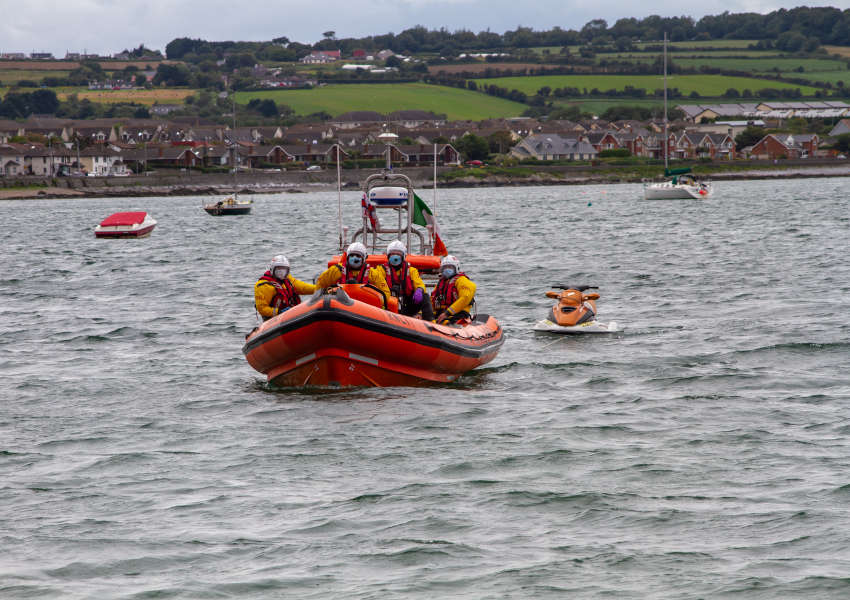 Skerries RNLI towing a broken-down jet ski ashore | RNLI/Gerry Canning
Skerries RNLI towing a broken-down jet ski ashore | RNLI/Gerry Canning
The lifeboat first launched on Sunday (26 July) shortly after 2pm to return two men on a jet ski safely back to shore after they suffered mechanical difficulties off Colt Island.
Then just two hours later the volunteers were called upon alongside the Irish Coast Guard helicopter Rescue 116 and Skerries coastguard unit to carry out a search for a swimmer in distress in the same area, between Colt Island and St Patrick’s Island.
Following a thorough search, and the crew speaking to numerous kayakers in the area, Dublin Coast Guard was satisfied that it was a false alarm with good intent and the helicopter and lifeboat were stood down.
Speaking later, volunteer lifeboat press officer Gerry Canning said: “It’s days like this that you really see the dedication of our volunteer crews.
“Some of them were still on the harbour following the first call out when their pagers sounded the second time. This meant that we could launch quite quickly to what was potentially a serious incident. Thankfully in both cases it was a good outcome.”
Skerries Lifeboat Tows Jet Ski To Safety After Breakdown
Skerries RNLI volunteers towed a jet ski with a man and woman on board to safety after they broke down near Barnageeragh beach in North Co Dublin.
Shortly after 5pm yesterday evening (Friday 26 June), the volunteers launched the Atlantic 85 inshore lifeboat following a 999 call to Dublin Coast Guard from a jet ski that had broken down.
They located the casualty in shallow water near a large rocky outcrop between Barnageerah and Balbriggan.
The man and woman were taken on board the lifeboat while the jet ski was taken under tow, and they were returned safely to the slipway at the lifeboat station in Skerries.
Speaking about the callout, volunteer lifeboat press officer Gerry Canning said: “You never know when something is going to go wrong, so we’d like to remind anyone going to sea to carry a means of contacting the shore to call for help.”
Elsewhere, Wicklow RNLI brought three fishermen to safety on Thursday afternoon (25 June) after their 12-metre vessel developed mechanical problems off the Wicklow coast.
The alarm was raised after the vessel which was fishing for whelk broke down and lost all propulsion.
Crew on the all-weather lifeboat Jock & Annie Slater located the stricken vessel about nine miles north of Wicklow Harbour, and towed it back to the harbour where it was brought safely alongside the South Quay.
Sea swimmer and experienced kayaker Kevin O’Sullivan has presented Skerries RNLI with a donation of €1,200 from monies raised while kayaking solo around the island of Ireland.
Kevin’s three-year venture started in 2016 and was spurred by his love of kayaking.
“After over 35 years of kayaking, looming large in front of me was my own personal edge,” he explains of his decision to embark on the solo circumnavigation.
“I had been operating as a volunteer kayak instructor with Skerries Sea Scouts for seven years. Being inspired by the courage of the many junior paddlers within their ranks, I decided it was high time I ventured outside my own comfort zone as this mission materialised out of the faintest whisper of a long-held dream I had thought about for years.”
During the planning of the trip, Kevin said he was aware of the work done by volunteers at his local RNLI station in Skerries, and Medicins Sans Frontiers in the Mediterranean.
“I decided to put a charity element to my venture. Monies raised were split down the middle and shared.
“My local involvement with The Frosties, a year-round sea swim group, gave me first-hand knowledge of the very critical service the RNLI offers to all water users. We have availed of their service on a few occasions.
“I am not alone in complimenting their non-judgemental approach to any rescue they carry out. It is wonderful to give something back to this great organisation.’
Kevin’s circumnavigation was all the more remarkable in that he achieved it in his spare time, committing to the adventure for almost three years.
“I would kayak a stretch over a few days, camping as I went, depositing my kayak with a helpful soul, whilst returning home to family and work for a period.

“When the next favourable weather window opened coincident with my time off work, I would return to my boat continuing along the coast, all the while eating away at the total distance of 1,750 km to put me back into Skerries where I started.”
First circumnavigated in 1978 by a three-man team, around 100 have now completed the trip, mostly in small groups.
“Only 25 of these have been solo. Mick O’Meara, from Waterford, holds the record at 23 days, and was my own personal inspiration for the trip.”
Kevin says he wasn’t sure he could “stomach” the challenge due to his propensity for sea sickness, but the story of Mick O’Meara kept his spirits up.
“Thankfully I was graced with good weather, great support and my body held out so that after three summers, my kayak found itself being slid back onto its rack after a 903-day absence.”
Kevin recalled of his achievement: “I camped, B&Bed, was put up by strangers, slept in adventure centres, friends’ houses and hostels. I used planes, trains and automobiles to get to and from the remotest corners of this island to complete my paddling project.
“Once, in fact, I walked two-and-a-half kilometres on the Hook Peninsula to get to my B&B from the beach I landed on, back in November 2017. The proprietor, who very kindly reopened his B&B for me, stood shocked when I rolled my 18ft long kayak up his driveway rather than atop my car.”
Gerry Canning, volunteer lifeboat press officer for Skerries RNLI, commended Kevin for his fundraising efforts on behalf of the station.
“This was a phenomenal effort with an amazing amount raised for Skerries RNLI and we want to say a huge thank you to Kevin. With so many fundraising events cancelled this year, donations like this are even more crucial.
“We can really feel Kevin’s pride for what he has achieved and his enthusiasm for helping the charities he donated to. These funds are very much appreciated by all here at Skerries and will help us to continue to save lives at sea.”
RNLI lifeboat crews from Skerries and Clogherhead launched yesterday (Monday 25 May) to retrieve a number of adults and children who had become stranded on rocks near Mornington Beach, east of Drogheda.
The lifeboats were launched shortly before 3pm after Dublin Coast Guard received emergency calls about the group’s welfare.
Also tasked were the Irish Coast Guard’s Dublin-based helicopter Rescue 116, the Drogheda Coast Guard boat, and a coastguard land unit, with all arriving on scene within minutes.
Two women, a man and three children were located on the breakwater on the Mornington side of the River Boyne. It’s understood that the women and children had managed to climb up onto the rocks after they were pulled out to sea by a strong current, and the man had come to their assistance.
Working together, Skerries RNLI and Drogheda Coast Guard used their inshore boats to transfer the woman and one of the children to Clogherhead’s all-weather lifeboat for a possible transfer to the helicopter.
However, after consultation with the woman and Rescue 116, it was decided to bring them to a waiting ambulance on Mornington pier to be assessed and treated for their injuries.
The two inshore boats then recovered the remaining casualties from the rocks and brought them to be checked out by ambulance paramedics.
Subsequently the lifeboat crew were informed that another child had also been in the water and had suffered cuts and bruises.
However, they had made it back to shore with assistance from one of the adults. That child was picked up from the beach with another adult and brought for assessment by the ambulance crews.
Speaking about the call out, volunteer lifeboat press officer for Skerries RNLI, Gerry Canning, said: “Any incident involving multiple casualties has the potential to be serious.
“This was another great example of how well our volunteers work alongside our colleagues from our flank stations, from the coastguard and indeed all the emergency services.
“We hope all the casualties involved make a full and speedy recovery.”


























